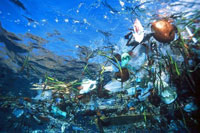Scientists Find 'Garbage Patch' In Pacific
Scientists recently returned from an expedition into the "Great Pacific Ocean Garbage Patch."

The Scripps Environmental Accumulation of Plastic Expedition (SEAPLEX) crew got a close up view of the plastic debris floating in a remote region of the Pacific Ocean.
The researchers left San Diego on August 2 to visit the garbage patch, located 1,000 miles off California’s coast.
Samples of the garbage were taken for analysis.
Little has been known about the size of the "garbage patch" and its threats to marine life until the team returned from their expedition on August 21, reports RedOrbit.
"It's pretty shocking — it's unusual to find exactly what you're looking for," said Miriam Goldstein, who led fellow researchers from the Scripps Institution of Oceanography at UC San Diego on the three-week voyage.
While scientists have documented trash's harmful effects for coastal marine life, there's little research on garbage patches, which were first explored extensively by self-trained ocean researcher Charles Moore just a decade ago. There's also scant research on the marine life at the bottom of the food chain that inhabit the patch.
But even the weather-beaten, sunbleached plastic flakes that are smaller than a thumbnail can be alarming, The Associated Press reports.
“We did observe a lot of plastic out there in the ocean about 1,000 miles from anything" said Miriam Goldstein, chief scientist on the Scripps Environmental Accumulation of Plastic Expedition (SEAPLEX). "It's pretty shocking."
A group of doctoral students and research volunteers from Scripps Institution of Oceanography at UC San Diego and Project Kaisei spent nearly three weeks on the research vessel New Horizon taking samples and exploring the plastic garbage patch floating in the North Pacific.
Over the next several months they will analyze samples to learn more about its toxicity and how it affects ocean life and food webs. Are invasive species getting a ride on the plastic? To what degree is the plastic interfering with ocean feeding?
Most of the plastic the ship encountered was small -- about the size of a thumbnail -- floating beneath the surface, Goldstein said, Los Angeles Times informs.
Subscribe to Pravda.Ru Telegram channel, Facebook, RSS!


